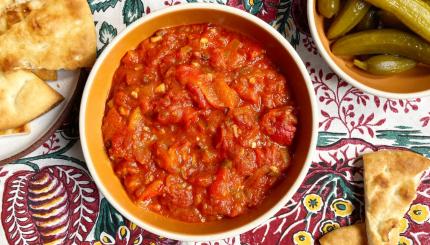The words "Jewish food" tend to conjure up images of Ashkenazic comfort foods like gefilte fish, Sephardic dishes like couscous with vegetables, or Middle Eastern delights like falafel and hummus. But with nearly six million Jews–approximately 40% of the world’s Jewish population–calling America home, American Jewish cuisine has become a category unto itself.
Many of the Tribe’s most iconic foods–such as blintzes, borscht, and brisket–were considered normal regional cuisine in the countries where they originated. It was not until Jews moved to the United States, and continued eating these foods, that they took on Jewish cultural significance.
In Jewish Cooking in America, author and culinary historian Joan Nathan argues that America has become a major "culinary center" for the Jewish Diaspora. Her comprehensive timeline begins in 1654, when 23 Sephardic Jews arrived in New Amsterdam, and follows the successive waves of Jews arriving in and spreading across the country. Not surprisingly, she tells the tale of a veritable Jewish melting pot (no pun intended!) in a country that "welcomed immigrants from all over the country [and also] incorporated their foods into the diet."
Packaging, Plenty, Partnership
Today, the majority of American Jewish foods can be defined by three common themes: packaging, plenty, and partnership. As Jewish immigrants transitioned from life as poor tenement dwellers to business owners, they began to package and market their favorite home- cooked foods.
With your help, My Jewish Learning can provide endless opportunities for learning, connection and discovery.
Companies like Manischewitz, Streit’s, Fox’s U-Bet, Rokeach, and Lender’s became synonymous with American Jewish food. They added legitimacy (if not quality) and a sense of permanence to Jewish cuisine, ensuring–for better or for worse–its inclusion on supermarket shelves for decades to come.
On this side of the Atlantic, Jewish food took on distinctly American-sized proportions. Being Jewish in America was, and still is, deeply tied to notions of material success, and what better way to prove one’s successes than with lavish amounts of food?
According to food historian Jennifer Berg, throughout the 20th century Jewish holiday meals and catered affairs such as Bar Mitzvahs and weddings were "all about quantity," as if one could solidify his status with an impressive chopped liver sculpture. The familiar dishes themselves also got super-sized. It is nearly impossible to imagine an Eastern European shtetl-dweller digging into an overstuffed corned beef sandwich or a puffy bagel slathered with an inch of cream cheese, but these giant-sized portions became de rigeur even for foods with very humble origins.
Meanwhile, Jews are by no means the only immigrant group to bring their culinary traditions to America. Over time, Jews have forged culinary partnerships with many other cultures, merging traditions together and, occasionally, simply incorporating another culture?s food into the Jewish canon. Think of the sushi invasion in kosher restaurants and at simchas, or matzo ball gumbo–a southern Jewish favorite that combines a Cajun classic with Jews? beloved soup dumpling. Nowhere else but America would Ruth and Bob Grossman have thought to write cookbooks on Chinese-kosher cooking.
Eco-Kashrut
More recently, a new trend has started to emerge in American Jewish cuisine: eco-kashrut. As interest in ecological and animal and human rights issues has risen in the US, a small but passionate group of Jews have begun to fold these ethics into their understanding of what it means to "eat Jewishly ." More and more individuals and families are joining community supported agriculture programs, and doing so from a foundation of Jewish values. And while many American Jews have abandoned keeping kosher, the call for ethically raised and slaughtered kosher meat is on the rise.
As the American Jewish community continues to shift and acculturate, the definition of American Jewish food will change with it. Some traditional foods will persist, while others will be lost as Jewish tastes, values, and budgets change. New foods and traditions will emerge, slowly taking their rightful place on the Jewish dinner table.
kosher
Pronounced: KOH-sher, Origin: Hebrew, adhering to kashrut, the traditional Jewish dietary laws.
Sephardic
Pronounced: seh-FAR-dik, Origin: Hebrew, describing Jews descending from the Jews of Spain.


